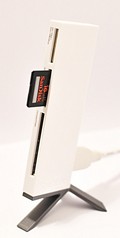Reading some old posts:
SanDisk Extreme 30 MB/s SD Card
SanDisk SDDR-199
SD Cards test with SDDR-1999
Now I know what was wrong with 30MB/s SanDisk Extreme SD cards. 30 MB/s was not standard bus speed for SD. So it is seems like only (one?) card reader from SanDisk was supporting that speed. And it was not a good idea to buy 30MB/s cards. Actually theoretical maximum speed for normal and high speed SD cards was 12.5 MB/s and 25MB/s (read as 10MB/s and 20 MB/s in real life). And, by the way, USB 2.0 (480 Mbit/s) has reallife speed for cardreader/hdd/etc ~ 30 MB/s at maximum.
New SD card standards are UHS-1 with 50 MB/s and 100 MB/s (read as 45 MB/s and 90 MB/s) and UHS-II with 156 MB/s and 312 MB/s.
So now some examples of UHS-1 standard in use:
SanDisk ImageMate SDDR-289 (USB 3.0)

USB 2.0 is not enough to get 45+ MB/s that is why UHS-* cardreaders must be USB 3.0 or other modern high speed interface.
Card formated to exFAT. Cardreaders setting “optimized for performance” in Windows 7.
| USB | Reader | Card | Read MB/s | Write MB/s |
|---|---|---|---|---|
| USB 3.0 | UHS-1 | UHS-1 45MB/s | 39MB/s | 24MB/s |
| USB 2.0 | UHS-1 | UHS-1 45MB/s | 26MB/s | 16MB/s |
| USB 2.0 | non UHS-1 | UHS-1 45MB/s | 18MB/s | 14MB/s |
Card Formatted to FAT32 by SD Formatter 3.1
| USB | Reader | Card | Read MB/s | Write MB/s |
|---|---|---|---|---|
| USB 3.0 | UHS-1 | UHS-1 45MB/s | 36MB/s | 32MB/s |
| USB 2.0 | UHS-1 | UHS-1 45MB/s | 25MB/s | 20MB/s |
| USB 2.0 | non UHS-1 | UHS-1 45MB/s | 18MB/s | 17MB/s |
speed tested with Flash Memory Toolkit “File Transfer (5MB)”
https://www.sdcard.org/developers/overview/speed_class/
http://compactflash.org/2010/cf-6-0-introduces-industry-leading-performance-and-feature-enhancements/

